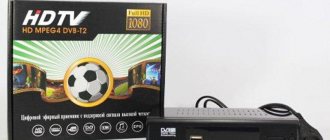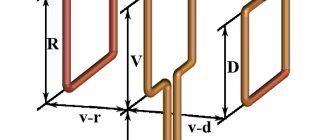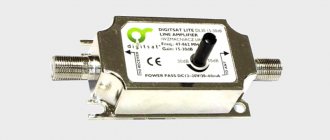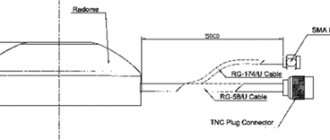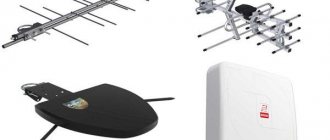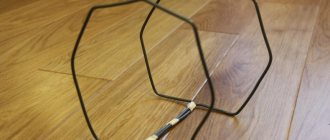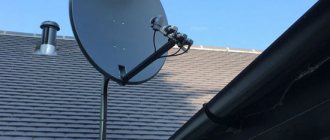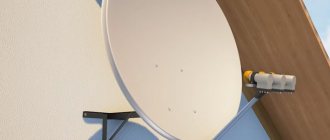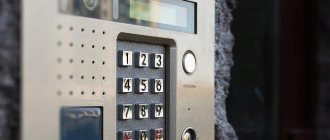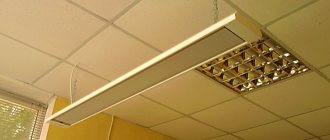The advantages of digital television over analogue can be discussed endlessly. Moreover, in Russia the transition to a new broadcasting format is approaching its logical conclusion and the vast majority of citizens have already managed to appreciate the wide selection of programs and enjoy the quality of sound and image. However, the issue of selecting, installing and connecting an antenna to equipment for viewing digital images is still relevant, since not everyone is ready to allocate additional funds to pay for the services of a specialist. Fortunately, following the detailed instructions and performing simple manipulations, anyone can handle the installation.
What equipment will be required for installation?
Today there are several digital broadcasting standards in the world, but in Russia the most popular is DVB-T2. To set up the reception of digital terrestrial channels, you must have a television antenna, a TV receiver, a set-top box and a connecting cable. However, the list of equipment may vary depending on the TV model and the distance of the house (apartment) from the repeater tower.
Antenna
Before choosing a device, you should decide whether it will pick up only digital signals, or whether it will retain the ability to receive analog signals. In the first case, the best option is considered to be antennas in the decimeter range (UHF) 300-850 MHz. They are compact in size and affordable. If there is a need to view regular channels, you should pay attention to an all-wave device with a reception range
MW+UHF.
Antennas can be indoor or outdoor. The first option is suitable for residents of apartment buildings, since they are located in an area of reliable signal reception. It is advisable to use external mounting devices to set up digital broadcasting in remote settlements.
Amplifier
Some antennas are equipped with a signal amplifier, however, such a device can be purchased separately. It has the ability to influence not only the direct signal, but also the reflected signal, so its use is justified when it is necessary to improve the quality of the broadcast. For example, in multi-storey buildings it will only do harm, as it will create interference, thereby reducing the quality of reception.
TV
Obviously, without a TV, you can’t set up digital TV, and it’s generally impossible to watch programs.
Models released after 2013 are equipped with a built-in DVB-T2 tuner. This means that the user will not need to buy a special digital set-top box. Older TV receivers do not have such a module, and they themselves support the DVB-T type, which is not compatible with the standard used in the Russian Federation. Therefore, owners of such TVs will have to additionally purchase a tuner.
Receiver
As noted, a digital set-top box is necessary when the TV does not support the DVB-T2 broadcast standard. Its functions include receiving and decoding the signal, converting it into sound and image, which are broadcast via TV. The modern market offers a wide range of similar devices with a wide range of functionality and low cost.
Do-it-yourself MV and UHF indoor antenna
If, in addition to UHF, there is a desire to receive MF, you can assemble a simple multiwave oven, its drawing with dimensions is presented below.
Indoor multiwave (MV and UHF) antenna
To amplify the signal, this design uses a ready-made SWA 9 unit; if you have problems purchasing it, you can use a home-made device, the diagram of which was shown above (see Fig. 2).
It is important to maintain the angle between the petals; going beyond the specified range significantly affects the quality of the “picture”.
Despite the fact that such a device is much simpler than a log-periodic design with a wave channel, it nevertheless shows good results if the signal is of sufficient power.
Where to point the antenna to receive digital TV
In metropolitan areas and large cities, the location of the TV tower does not play a significant role, since it broadcasts a strong and reliable signal. Residents in more remote areas need to know where the central repeater is located and whether there are obstacles in the signal path (mountains or hills, vegetation, tall buildings and obstacles). This is necessary because high-quality signal reception is possible if the antenna is pointed directly at the television tower.
In addition to the location, the user should receive the following information:
- The exact distance from the installed antenna to the repeater;
- Broadcast frequency to be able to tune channels manually;
- List of available channels. At the moment, two multiplexes are broadcasting free of charge - RTRS-1 and RTRS-2.
All this information is available on the provider’s website or on the “Interactive map of digital TV coverage area”. You just need to specify a specific location in the search bar and get a detailed plan of the area on the screen. The coordinates of the nearest towers, broadcast frequency and distance in kilometers will be indicated here.
How to install an antenna for digital television
In one article, it is almost impossible to analyze all the options for installing an antenna and setting up high-quality digital TV reception. Therefore, it is advisable to take a closer look at typical situations, for example, the features of installing an indoor or outdoor antenna, the procedure for connecting to a TV directly or through a digital set-top box.
As already mentioned, an antenna mounted outside is capable of receiving a higher quality signal. That’s why it costs an order of magnitude more than a room one. If it is not possible to purchase an outdoor module, you can opt for an indoor model and install it within a room (apartment or house). Do not forget that for “digital” you should use a decimeter antenna, which should be directed towards the repeater. This will improve the signal quality and watch programs in excellent quality. Internal or external receivers differ in design, size, and installation specifics. The last characteristic is worth considering in more detail.
Room
If the distance from the repeater to a residential building (house, apartment) does not exceed 5 km, it makes sense to install the receiving device indoors. Many antennas are equipped with special devices that allow the user to fix the transmitting/receiving module on a TV or curtain. However, practice shows that the ideal location is still a window sill.
When using an indoor antenna, it is recommended to pay attention to the following points:
The antenna must be placed near the window so that the plastic (or wooden) frame does not interfere with the signal.- Make sure there are no sources of radio interference nearby (for example, a Wi-Fi router).
- The distance between the receiver and television equipment (TV, receiver, router) should be several meters.
After installation, you need to turn the antenna towards the repeater (after having established its location using an interactive map of the area).
External
To install the antenna outdoors, it is important to purchase a model that is designed for outdoor installation. The structure must be securely fixed so that it does not change its original position under the influence of wind and precipitation. The antenna is usually installed on the roof of a house or the facade of a building on special brackets mounted into the wall. But before you finally fix it, you need to check the quality of the received signal. To do this you will need:
- Choose a place that is protected from strong gusts of wind, but provides free passage of the signal.
- Turn the antenna towards the repeater.
- Slowly rotate the TV antenna to the right and left to determine the maximum directivity.
To correct actions, you need to invite an assistant: he must be in the apartment and report as soon as a clear image appears. Finally, you will need to firmly fix the device to prevent unexpected changes in position and directional vector.
Selection of recommended television antennas for DVB-T2
It is difficult to answer the question: will it show digital television with an indoor antenna without purchasing it and trying it in action in local conditions. You need to understand whether you need a powerful indoor DVB-T2 antenna with an amplifier or whether the signal in your home is so strong that a passive catcher will do.
REMO BAS-5320-USB Inter 2.0
The purchased device, even if it is internal, must have a radiation pattern that is at least slightly different from the geometric circle.
You may be interested in: Plan to switch off analogue television in Russia
Wavelength receivers that have a chance of success have one thing in common: they are highly directional and are good at picking up the signal from the direction they are looking, while trying to ignore extraneous signals. A narrow beam model is the first step towards good digital television reception in the room.
REMO BAS-5310USB HORIZON
By this time, the domestic buyer has already formed a certain rating of models in the “appearance-cost-functionality” ratio, which will help you choose an indoor antenna for your TV.
The best indoor antennas with amplifier for TV:
- REMO BAS-5320-USB Inter 2.0 is an all-wave indoor active model that reliably picks up digital and analog signals. The amplifier is powered by an adapter or via USB. The device has an innovative design, its body is durable and ergonomic;
- REMO BAS-5310USB HORIZON - a device of this brand is designed for areas with very good reception. It has a minimalistic appearance, due to which it will successfully fit into a single composition with any TV and tuner, and can be attached directly to the TV. Type – active;
- DENN DAA210 - this active internal design combines many things: compactness, an active method of receiving radio and terrestrial television signals (T2 and analogue), built-in noise reduction device, affordable cost;
- VIVANCO is a family of active and passive models for the home, which has proven itself well in digital and analogue reception at various frequencies.
Recently, panel antennas have been gaining popularity. They have a compact design housed in a flat body. For a relatively low price, you get a universal receiving device: it is suitable for use both outdoors and indoors. Models of this design provide good TV signal reception.
Which cable to choose and how to lay it
The quality of digital TV broadcasting depends not only on the correct installation of the antenna, but also on the cable used.
The modern market offers dozens of wire models; it is not surprising that users have a lot of questions about choosing the best option. Answers to the most frequently asked questions can be found below.
Vyacheslav
For several years he worked in mobile phone stores of two large operators. I understand tariffs well and see all the pitfalls. I love gadgets, especially Android ones.
Ask a Question
Question to the expert
Does the signal level depend on the conductor cross-section?
Yes, directly. The larger the cross section, the better the impulse is transmitted over long distances. If the receiver is located 30 m away from the repeater, this figure should be 1 mm².
What material is the conductor made of?
Made of copper and copper-plated steel.
Does the amount of attenuation affect signal quality?
Yes, in inverse proportion. The smaller the value, the higher the quality.
What characteristic impedance should a cable for digital TV have?
It should be 75 ohms. Sometimes sellers offer RG-58A or RG-58C models, but they are not suitable for digital broadcasting
What brands of coaxial cable for digital television are popular?
Today there are several models that meet the requirements of digital broadcasting. These are: RG-6U; RK-75; SAT-50; SAT-703; DG-113.
How to adjust the signal quality on the antenna
If, after connecting the antenna to the TV or receiver, the signal begins to disappear, you will need to determine its level and make adjustments. To do this you will need the following:
- Disconnect all appliances.
- Connect the coaxial cable at one end to the antenna, and insert the other into the “ANT IN” jack on the TV panel or “RF IN” on the set-top box.
- Next, connect the TV to the receiver via RCA or HDMI connectors (depending on which one is available).
- Insert the plug into the outlet and turn on the TV. Specify the signal source used.
- When the receiver menu window appears, press the “Menu” button on the remote control.
Select the “Search” option, go to the “Manual search” mode and set the range to “UHF” (UHF). - If everything is done correctly, two scales should appear. One reflects the power, the other reflects the signal quality.
Now you need to go to the antenna and ask an assistant to observe the change in levels. By performing slow rotations in different directions (the reaction of the signal to the action comes with a delay), ensure that the scales are filled as much as possible.- Having chosen the best position, securely fasten the antenna.
Connecting multiple TVs to one antenna
Connecting several TVs to one antenna is done using one of the following technologies:
- using a cable TV signal splitter;
- using signal splitters.
When connecting several TVs to one TV antenna cable and if there is a splitter or splitter, the signal will be divided between the TVs, and the image quality will be determined by the characteristics of each TV.
On each of them you can adjust the image in accordance with the settings on the TV. The signal splitter transmits the signal in its pure form to each of the TVs.
Thus, each TV will have its own image, as well as its own audio and video (for example, if you connect a second TV to the audio system). In addition, you can install several antenna sockets on the antenna, then you can connect several TVs to it. In this case, each TV will have its own image and audio.
Splitters and signal splitters are connected to the antenna with one cable, but the splitter transmits the signal to several TVs, and the splitters also distribute it between different antenna sockets.
